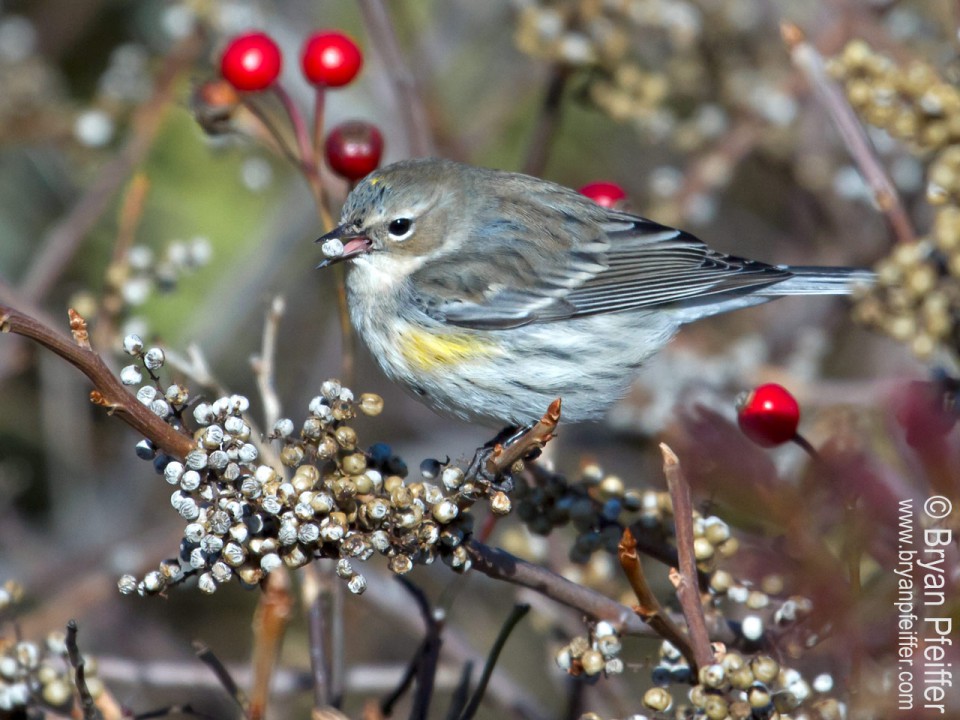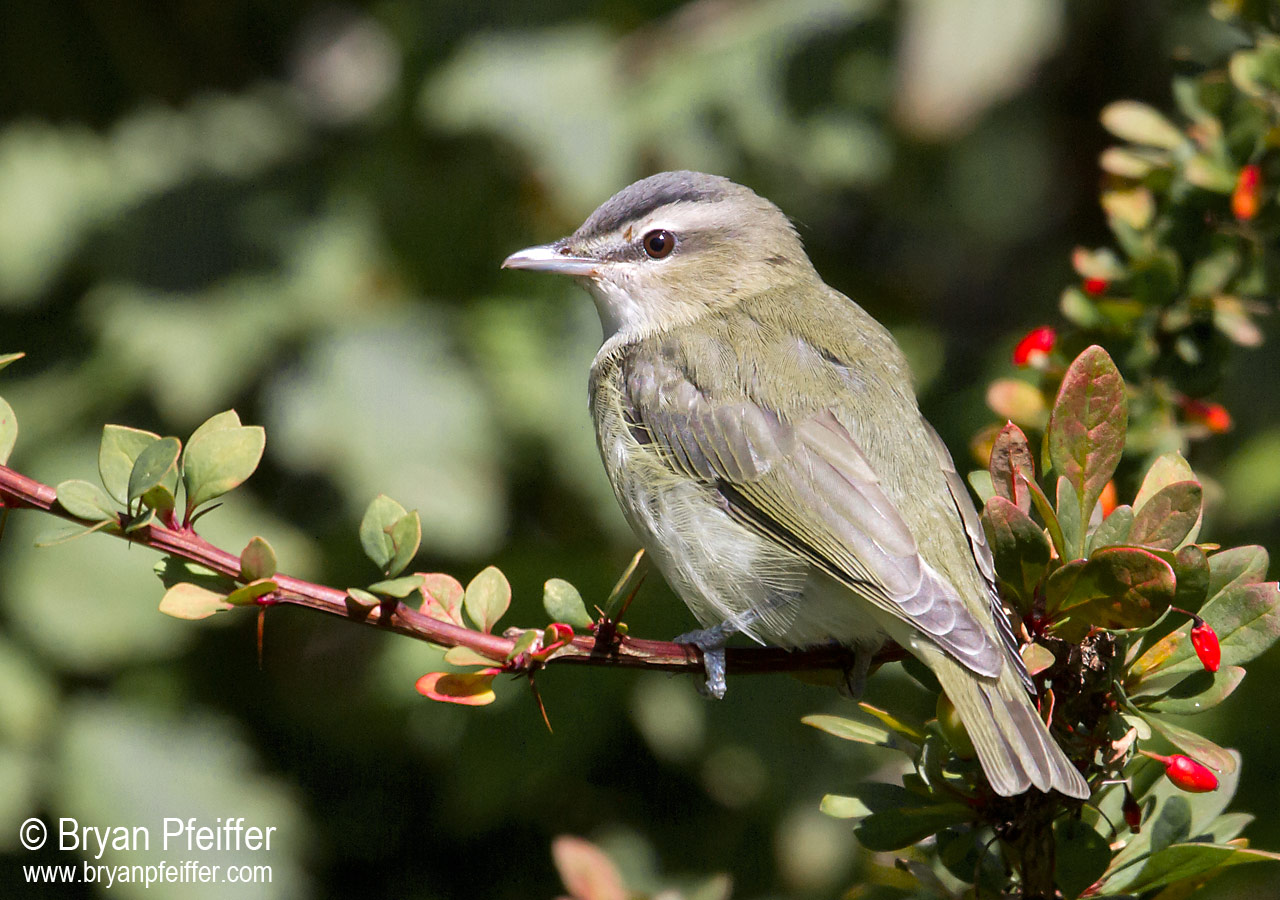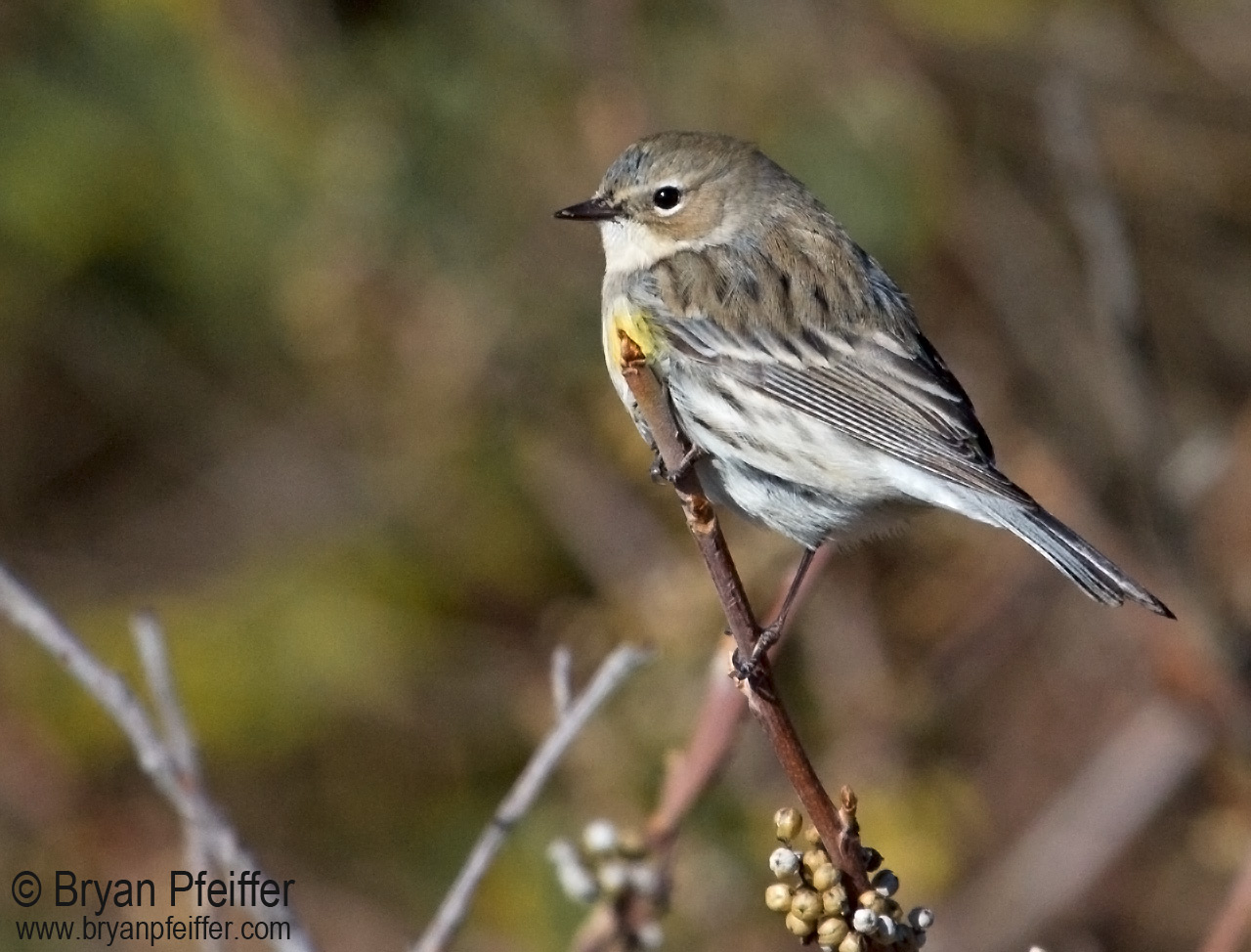The Crazy Stuff Birds Eat
Note: This is a version of my regular column in Northern Woodlands.
FOR MANY OF US who watch their behavior, birds are what they eat — or at least are predictable in their diets: Kingfishers catch fish. Hummingbirds drink nectar. Robins eat earthworms. Flycatchers catch flies.

A Yellow-rumped Warbler eating poison ivy fruits in Massachusetts (November 2014) / © Bryan Pfeiffer
Except when they don’t.
Plenty of birds go off their diets, breaking the rules or notions we often harbor about what they eat.
I’ve seen a Herring Gull crush and swallow an Arctic Tern chick, and a Bald Eagle nibble on the leg of a road-flattened Northern Leopard Frog. I’ve watched a Snowy Owl try to catch fish or ducks at sea, and a Great Blue Heron unearth and swallow a gopher. What may seem unsavory to us, is usually an avian delicacy.
Migration drives big changes in diet. Besides requiring raw determination and innate navigational skills, migration takes calories, lots of them, stored as fat and burned as fuel on long-distance flights. Insects are a fine source of protein and fat for southbound songbirds every fall.
But insects become scarce during the fall migration, which would seem to be a problem for classic insect eaters such as flycatchers and warblers. So the insectivores go for the next best thing: fruit. In one study of 69 bird species stopping on Block Island, Rhode Island, all but one (Winter Wren) had fruit in their droppings. Least Flycatchers, Blackpoll Warblers, Red-eyed Vireos and scores of other self-respecting insectivores find essential fuel in the fruits of viburnum, bayberry, pokeweed, Virginia creeper, and other shrubby plants and vines.
Gram for gram, fruit is lower in lipids and protein than insect tissue. Even so, some birds fare well at the fruit bar, particularly avian omnivores such as tanagers and sparrows, which tend to eat fruit year-round and can maintain body mass and conditioning on a fruit diet during migration.
The classic insectivores in the study, however, did not fare as well when fruit constituted a greater portion of their diet. Yet they often don’t have much choice. On the journey south, songbirds might stop where fruit is the only option. If you were weak and hungry with miles to go, you might settle for an apple if your hamburger weren’t available.

A Red-eyed Vireo on the invasive Japanese barberry on Monhegan Island, Maine (September of 2014) / © Bryan Pfeiffer
For many migrants on their way south, the eastern seaboard offers a banquet of fruits such as rose hips, bittersweet, and poison ivy. Bayberry, a waxy source of fat for otherwise insectivorous Yellow-rumped Warblers and Tree Swallows, grows in abundance along the east coast. But the coast is also where a good many people live. Ornithologists now recognize the value in keeping these shrubby swaths of habitat (even some invasives) from being replaced by lawns or housing or shopping malls. For many songbirds, it’s not only about the breeding and wintering grounds; it’s also about the fruity turf that lies between.
What may seem odd to us, of course, usually isn’t so odd for birds. Nature has a way of toppling our assumptions. Those of us in the Northeast, for example, who see warblers and flycatchers turning from insects to fruit in autumn, might have it backwards. After all, many of those birds came here to nest and to feed their young from our spring flush of black flies, mosquitoes, and inchworm caterpillars. They visit for three or four months of the year – and then they’re gone, back to the tropics to eat fruit.
So a songbird that we know as insectivorous may, in fact, be little more than a fruitarian that in spring prefers to eat bugs.
Reference:
Parish, J.D. Patterns of frugivory and energetic condition in Nearctic landbirds during Autumn migration. The Condor. v. 99, no. 3, p. 681-697.


I know this is years old, but wondering if anyone has done any substantive peer reviewed work on the increase of introduced plants and insect pests to the decrease of native birds? It seems to me the number of introduced/naturalized/invasive species correlates pretty well to overall decline in songbirds.
I am here because I was looking for evidence that blackpolls eat viburnum/dogwood, thank you. In my area we are losing the viburnums to the Viburnum leaf beetle (Pyrrhalta viburni) and alternate leafed dogwood (Cornus alternifolia) to Golden Canker (Cryptodiaporthe canker). Thank you for this blog post!
I am a native plant gardener who has seen amazing results by removing introduced plants and replacing them with native species. I was also looking for alternative suggestions to replace this important food source, as we had blackpoll on the property for the first time this year. A “lifer” in the back yard FAR surpasses “pretty” exotics that compete for our thin soils and give nothing back to the ecology. I look at the world from the plant’s point of view, as the plants will determine the insect/bird life that is supported on virtually any piece of ground.
This is the best response I can make to the Anthropocene.
Hey, Terry. Wow! THAT I gotta see! (And egrets gotta eat!)
One of the more disturbing things I’ve observed is Great Egrets eating spring warblers in April, at Fort Jefferson, Dry Tortugas NP. The little guys have just crossed the Gulf of Mexico and are exhausted, so easy pickings for the opportunistic feeders.
Wow. Thanks, Kent. Habitat AND food segregation. Any data on what any females you might find in the cloud forests prefer?
Red-eyed Vireos will take a good portion of fall fruits that I’ve mentioned. I’ve seen them eat dogwood and honeysuckle fruits in the fall. I had suspected that they would not eat bayberry, but here’s a list (from literature sources cited by Birds of North Amerca) of some of what they’ve been known to eat: blackberries/dewberries (Rubus spp.), elderberries (Sambucus canadensis), spicebush (Lindera benzoin), Virginia creeper (Parthenosisus quinquefolia), sassafras (Sassafras albidum), dogwood (Cornus spp.), northern arrowwood (Viburnum recognitum), and northern bayberry.
We’ve done some work on Bicknell’s Thrush winter diet. It turns out that birds in secondary habitat, mostly females, are serious fruit eaters. While those in cloud forest are mostly males and dine on arthropods.
I knew about Tree Swallow’s and Yellow-rumped Warblers feeding on Bayberries. What fruit do Red-eyed Vireos feed on then?